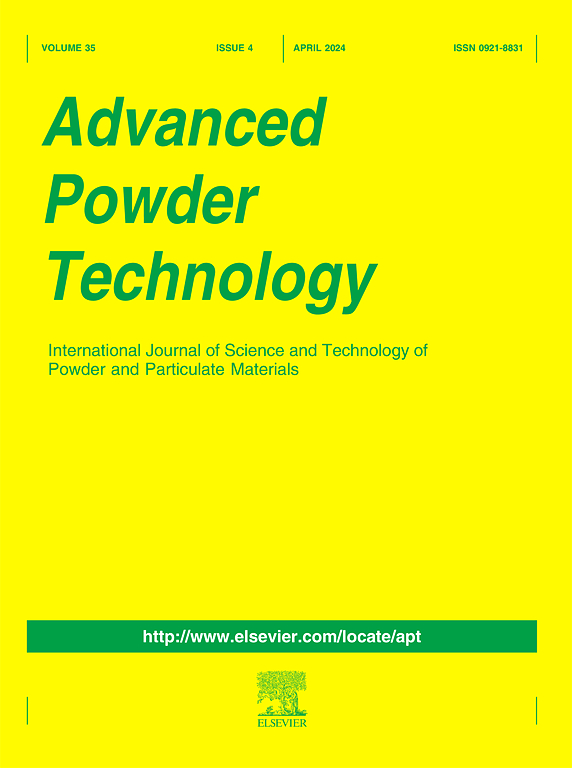Heterostructure-reinforced CoCrFeNiTax (x = 0.5 and 1) high-entropy alloy coatings fabricated by combining mechanical alloying and hot-pressing sintering
IF 4.2
2区 工程技术
Q2 ENGINEERING, CHEMICAL
引用次数: 0
Abstract
The high-performance CoCrFeNiTa0.5 (Ta0.5) and CoCrFeNiTa (Ta1) high-entropy alloy coatings (HEACs) consolidated on the Q235 substrate were synthesized via mechanical alloying and vacuum hot-pressing sintering. The final milled Ta0.5 and Ta1 powders consist of dual body-centered cubic phases, with the Ta1 powder additionally containing an amorphous phase. Both HEACs comprise double face-centered cubic solid-solution matrix with intermetallic compound. Distinct precipitate distribution patterns are observed across four characteristic regions: the transition boundary, fine-grained layer, coarse-grained layer, and normal region. These microstructural features contribute to excellent interfacial bonding, as evidenced by the bending strengths of 586 MPa (Ta0.5) and 531 MPa (Ta1). Due to the thicker fine-grained layer adjacent to the substrate, the Ta0.5 coating exhibits superior resistance to shearing forces and bending moment, resulting in higher bending strength. The Ta1 coating achieves optimized microhardness, showing 256 % and 28 % improvements over the substrate and Ta-free CoCrFeNi coating, respectively. Furthermore, wear resistance tests confirm that both HEACs outperform the substrate. The enhanced microhardness and wear resistance are attributed to solid-solution strengthening (from larger Ta atoms), second-phase strengthening (via nanoscale Laves phases), and the synergistic effect of the dual FCC matrix with uniformly distributed nanoscale hard phases. Electrochemical corrosion tests display that both HEACs demonstrate superior comprehensive corrosion resistance in a 3.5 wt% NaCl solution, primarily due to the formation of protective Ta oxides.

机械合金化与热压烧结相结合制备异质结构增强CoCrFeNiTax (x = 0.5和1)高熵合金涂层
采用机械合金化和真空热压烧结的方法,在Q235基体上合成了高性能CoCrFeNiTa0.5 (Ta0.5)和CoCrFeNiTa (Ta1)高熵合金涂层。最终的Ta0.5和Ta1粉末由双体心立方相组成,Ta1粉末中还含有非晶相。两种HEACs均由双面心立方固溶基质和金属间化合物组成。在过渡边界、细粒层、粗粒层和正态区四个特征区域中观察到不同的沉淀分布模式。这些微观结构特征有助于良好的界面结合,证明了抗弯强度为586 MPa (Ta0.5)和531 MPa (Ta1)。由于Ta0.5涂层与基体相邻有较厚的细晶层,因此Ta0.5涂层具有较好的抗剪力和抗弯性能,从而具有较高的抗弯强度。Ta1涂层的显微硬度比基体和不含ta的CoCrFeNi涂层分别提高256%和28%。此外,耐磨性测试证实,这两种heac的性能都优于基板。显微硬度和耐磨性的提高主要归因于固溶强化(来自较大的Ta原子)、第二相强化(通过纳米级Laves相)以及双FCC基体与均匀分布的纳米级硬相的协同作用。电化学腐蚀试验表明,这两种HEACs在3.5 wt% NaCl溶液中表现出优异的综合耐腐蚀性,这主要是由于形成了保护性的Ta氧化物。
本文章由计算机程序翻译,如有差异,请以英文原文为准。
求助全文
约1分钟内获得全文
求助全文
来源期刊

Advanced Powder Technology
工程技术-工程:化工
CiteScore
9.50
自引率
7.70%
发文量
424
审稿时长
55 days
期刊介绍:
The aim of Advanced Powder Technology is to meet the demand for an international journal that integrates all aspects of science and technology research on powder and particulate materials. The journal fulfills this purpose by publishing original research papers, rapid communications, reviews, and translated articles by prominent researchers worldwide.
The editorial work of Advanced Powder Technology, which was founded as the International Journal of the Society of Powder Technology, Japan, is now shared by distinguished board members, who operate in a unique framework designed to respond to the increasing global demand for articles on not only powder and particles, but also on various materials produced from them.
Advanced Powder Technology covers various areas, but a discussion of powder and particles is required in articles. Topics include: Production of powder and particulate materials in gases and liquids(nanoparticles, fine ceramics, pharmaceuticals, novel functional materials, etc.); Aerosol and colloidal processing; Powder and particle characterization; Dynamics and phenomena; Calculation and simulation (CFD, DEM, Monte Carlo method, population balance, etc.); Measurement and control of powder processes; Particle modification; Comminution; Powder handling and operations (storage, transport, granulation, separation, fluidization, etc.)
 求助内容:
求助内容: 应助结果提醒方式:
应助结果提醒方式:


